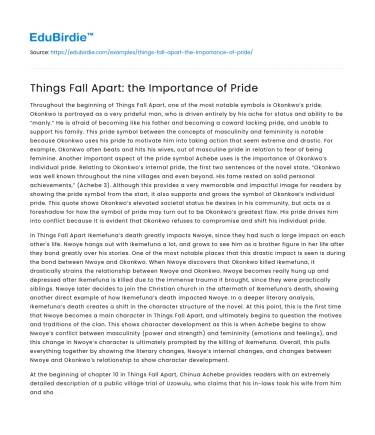Throughout the beginning of Things Fall Apart, one of the most notable symbols is Okonkwo’s pride. Okonkwo is portrayed as a very prideful man, who is driven entirely by his ache for status and ability to be “manly.” He is afraid of becoming like his father and becoming a coward lacking pride, and unable to support his family. This pride symbol between the concepts of masculinity and femininity is notable because Okonkwo uses his pride to motivate him into taking action that seem extreme and drastic. For example, Okonkwo often beats and hits his wives, out of masculine pride in relation to fear of being feminine. Another important aspect of the pride symbol Achebe uses is the importance of Okonkwo’s individual pride. Relating to Okonkwo’s internal pride, the first two sentences of the novel state, “Okonkwo was well known throughout the nine villages and even beyond. His fame rested on solid personal achievements,” (Achebe 3). Although this provides a very memorable and impactful image for readers by showing the pride symbol from the start, it also supports and grows the symbol of Okonkow’s individual pride. This quote shows Okonkwo’s elevated societal status he desires in his community, but acts as a foreshadow for how the symbol of pride may turn out to be Okonkwo’s greatest flaw. His pride drives him into conflict because it is evident that Okonkwo refuses to compromise and shift his individual pride.
In Things Fall Apart Ikemefuna’s death greatly impacts Nwoye, since they had such a large impact on each other's life. Nwoye hangs out with Ikemefuna a lot, and grows to see him as a brother figure in her life after they bond greatly over his stories. One of the most notable places that this drastic impact is seen is during the bond between Nwoye and Okonkwo. When Nwoye discovers that Okonkwo killed Ikemefuna, it drastically strains the relationship between Nwoye and Okonkwo. Nwoye becomes really hung up and depressed after Ikemefuna is killed due to the immense trauma it brought, since they were practically siblings. Nwoye later decides to join the Christian church in the aftermath of Ikemefuna’s death, showing another direct example of how Ikemefuna’s death impacted Nwoye. In a deeper literary analysis, Ikemefuna’s death creates a shift in the character structure of the novel. At this point, this is the first time that Nwoye becomes a main character in Things Fall Apart, and ultimately begins to question the motives and traditions of the clan. This shows character development as this is when Achebe begins to show Nwoye’s conflict between masculinity (power and strength) and femininity (emotions and feelings), and this change in Nwoye’s character is ultimately prompted by the killing of Ikemefuna. Overall, this pulls everything together by showing the literary changes, Nwoye’s internal changes, and changes between Nwoye and Okonkwo’s relationship to show character development.
Save your time!
We can take care of your essay
- Proper editing and formatting
- Free revision, title page, and bibliography
- Flexible prices and money-back guarantee
At the beginning of chapter 10 in Things Fall Apart, Chinua Achebe provides readers with an extremely detailed description of a public village trial of Uzowulu, who claims that his in-laws took his wife from him and should therefore give him his wife price back. This shows the tip of how the setting of chapter 10 uses setting to show gender motifs, but is expanded when the ceremony itself is described. Achebe states, “It was clear from the way the crowd stood or sat that the ceremony was for men. There were many women, but they looked on from the fringe like outsiders” (Achebe 87). This shows direct ties between the trial’s location and themes of gender roles which are undeniably present throughout the novel. Achebe later goes on to provide a detailed description of egwugwu, which represents the spirit of the clans ancestors (Achabe 88-90). This detail about setting and location provides a link to culture and tradition, which prove as majorly distinguished motifs in the novel. Overall, Achebe uses the setting and location described at the beginning of chapter 10 to set the scene for the clans trial, which then turns to show further visuals of the distinguished motifs and themes throughout Things Fall Apart.
When looking at the novel in its entirety, it is extremely notable to notice the division of the novel into Part 1, Part 2, and Part 3. The various parts show character development as it is key when certain characters become important, using the previous example of Nwoye as an example. From a literary analysis aspect, this structure allows significant plot and character development. Part 1 is focused on introducing Okonkwo, the novel’s main character, and explaining his history, status, and family. This allows Okonkwo’s character to be established right off the bat, simply because the entire first section of the novel is written for this purpose. Moving to Part 2, it dives more into the change faced by the village, and the cultural shift that is ultimately occurring in the clan. Again, this division of the novel allows significant plot elements such as symbols, motifs, and themes to be established. Part 3, the last section of the novel shows Okonkwo’s return to the village and ties together the pieces of all the change the clan has gone through. This proves to be the climax of Things Fall Apart, important to note in the structure as it accentuates the downfall of the clan, which would have been significantly less prevalent and impactful without this same structure. Achebe used division of the novel into 3 different parts to create impact and place emphasis on the clans loss of customs, which would’ve lacked this emphasis if less was known about the clan than what was shown through the different parts of the novel.






 Stuck on your essay?
Stuck on your essay?

